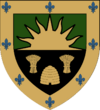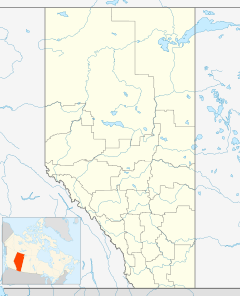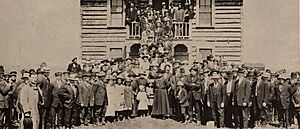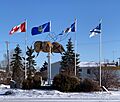Falher facts for kids
Quick facts for kids
Falher
|
|||
|---|---|---|---|
|
Town
|
|||
| Town of Falher Ville de Falher |
|||

The world's largest honey bee Statue
|
|||
|
|||
| Nickname(s): | |||
| Country | Canada | ||
| Province | Alberta | ||
| Region | Northern Alberta | ||
| Census division | 19 | ||
| Municipal district | Municipal District of Smoky River No. 130 | ||
| Incorporated | |||
| • Village | September 5, 1923 | ||
| • Dissolution | August 9, 1926 | ||
| • Village | March 13, 1929 | ||
| • Town | January 1, 1955 | ||
| Area
(2021)
|
|||
| • Land | 2.83 km2 (1.09 sq mi) | ||
| Elevation | 587 m (1,926 ft) | ||
| Population
(2021)
|
|||
| • Total | 1,001 | ||
| • Density | 354.1/km2 (917/sq mi) | ||
| Time zone | UTC−7 (MST) | ||
| • Summer (DST) | UTC−6 (MDT) | ||
| Area code(s) | +1-780 | ||
| Highways | Highway 49 Highway 2 |
||
Falher is a town in the Peace River Country area of Alberta, Canada. It is located in the Municipal District of Smoky River No. 130, along Highway 49. Falher is famous for being the "Honey Capital of Canada." It also has the highest percentage of French speakers in Western Canada, with 52% of its residents speaking French as of 2021.
Contents
- What's in a Name? The Story of Falher
- A Look Back: The History of Falher
- Who Lives in Falher? Population Facts
- How Falher Makes a Living: The Economy
- Fun and Culture in Falher
- What to See and Do: Attractions in Falher
- Learning in Falher: Education
- News and Media in Falher
- Famous People from Falher
- Images for kids
What's in a Name? The Story of Falher
The name Falher comes from Father Constant Falher. He was a Roman Catholic missionary from France. In 1912, the first group of settlers chose the name "Saint-Jean-Baptiste de Falher" for their new community. This name combined the first name of Father Jean-Baptiste Henri Giroux with Father Falher's last name.
The name "Falher" itself comes from a French word. It means "scytheman," which is someone who uses a scythe. A scythe is a tool for cutting grass or crops.
How the Cree People Named the Area
The Cree people had their own names for this area. They called the settlements of Falher, Donnelly, and Girouxville together umstosee owuskee. This means "Frenchman's Land." Another Cree name for Falher and Donnelly was mistik asissw owaski. This means "Little Stick House," referring to the mission church.
A Look Back: The History of Falher
Before settlers arrived, missionaries knew this area. It was an Indian trail leading to British Columbia. Later, a railway was built along this path. In 1912, the first settlement, Mission Saint-Jean-Baptiste de Falher, was started. It was about 5 kilometers (3 miles) from where Falher is today.
When the railway came in 1915, the settlement was named after Father Constant Falher. Many early settlers came from Quebec. Some even came from the United States of America.
How Falher Grew Over Time
The original colony split into two parts. These became the Village of Donnelly and the Town of Falher. In 1919, Falher set up its first school district. The first church, Ste. Anne Parish, was also built.
Falher opened its first post office in 1923. It officially became a village in 1929. Then, in 1955, it became a town. In 1963, Falher celebrated its 50th anniversary. Over 5,000 people attended this big event!
Who Lives in Falher? Population Facts
|
||||||||||||||||||||||||||||||||||||||||||||||||||||||||||||||||||
In 2021, the Town of Falher had a population of 1,001 people. This was a small decrease from its 2016 population of 1,047. The town covers an area of 2.83 square kilometers (1.09 square miles). This means about 354 people live in each square kilometer.
How Falher Makes a Living: The Economy
The main ways people make a living in Falher are through agriculture (farming), forestry (working with trees), oil, and gas.
The Story of Falher Alfalfa
Falher Alfalfa was a big business in the area. It processed alfalfa, a plant used for animal feed. It started in 1973 and was later sold to a group of local farmers. At its busiest, Falher Alfalfa employed about 110 people. However, the company faced financial problems. It went out of business in 2008 due to high production costs.
Fun and Culture in Falher
Falher is known for its annual Honey Festival. This festival started in 1970. It takes place every June. The festival celebrates the important beekeeping industry in the Smoky River region. This area produces a lot of honey, mainly from clover plants. At its best, the region's 48,000 beehives produced 10 million pounds (4,500 metric tons) of honey each year!
Falher also gained national attention in 2006. It did very well in the "Kraft Hockeyville" contest. This competition looks for the Canadian town that best loves hockey.
What to See and Do: Attractions in Falher
Falher is famous for its giant honey bee statue. You can find it on Main Street. This statue shows why Falher is called the "Honey Capital of Canada." A local welder built it. The statue is 22 feet 8 inches (6.9 meters) tall. Its base is 7 feet 7 inches (2.3 meters) wide.
The Falher Recreational Complex is a great place for sports. It has a hockey arena, a private gym, and a curling rink. The arena is home to the Falher Pirates. This is a hockey team in the East Division of the North Peace Hockey League.
Learning in Falher: Education
Falher has two public schools for students.
- École Héritage School: This is a Francophone (French-speaking) school. It is part of the Northwest Francophone Education Region No. 1. The school building used to be a college for farmers. It was built in 1951. École Héritage teaches students from kindergarten all the way to grade 12.
- École Routhier School: This school teaches in both English and French immersion. It is an Elementary School for grades K-6. After grade 6, students go to École Georges P. Vanier School in nearby Donnelly, Alberta.
News and Media in Falher
Falher has its own French-language community radio station, CKRP-FM. It has been on the air since 1996. Today, it is known as Nord-Ouest FM.
Since it was founded, Falher has had many French-language newspapers. These include La survivance, Le franco-albertain, and Le franco. Since 1966, the town has also had an English newspaper called The Smoky River Express.
Famous People from Falher
- Gabrielle Bugeaud (born 1952), a singer, musician, and actress.
- Robert LaPalme (1908-1997), a famous caricaturist (someone who draws funny pictures of people).
- Eveline Charles, a successful businesswoman.
- Hector Goudreau, a Canadian politician. He was a Member of the Legislative Assembly (MLA) for Central Peace-Notley from 2004 to 2015.
Images for kids








